The productivity of small ruminants in the Maasai pastoral system, Kajiado District, Kenya. An introduction to current research
Describes the research approach adopted by an interdisciplinary ILCA team to study a pastoralist production system, summarizing the methodology & results of research on small ruminants' productivity in the Maasai pastoral system, and outlining dif. features of current smallstock research in Kenya; w. an analysis of flock productivity, mortality, animal nutrition & behaviour at the Elangata Wuas group ranch.







